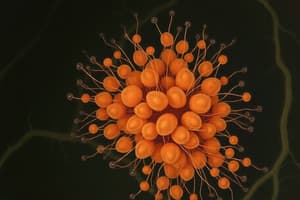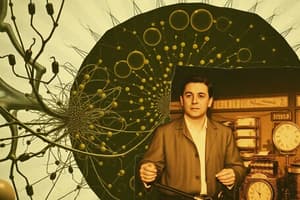Podcast
Questions and Answers
What differentiates the ends of a Golgi body?
What differentiates the ends of a Golgi body?
- Size and shape
- Membrane compositions (correct)
- Presence of ribosomes
- Type of molecules processed
Where do proteins synthesized by ribosomes on the RER go after being translocated into the ER?
Where do proteins synthesized by ribosomes on the RER go after being translocated into the ER?
- They are released into the cytoplasm
- They travel to the cis face of the Golgi apparatus (correct)
- They are stored in the central vacuole
- They are sent directly to the nucleus
What is the function of vesicles leaving the trans face of the Golgi apparatus?
What is the function of vesicles leaving the trans face of the Golgi apparatus?
- To transport proteins to various cell locations (correct)
- To synthesize new proteins
- To modify the proteins
- To digest cellular waste
What characterizes eukaryotic cells compared to prokaryotic cells?
What characterizes eukaryotic cells compared to prokaryotic cells?
What is the primary role of the Golgi apparatus?
What is the primary role of the Golgi apparatus?
Which component of the cell is described as a semifluid solution surrounded by the plasma membrane?
Which component of the cell is described as a semifluid solution surrounded by the plasma membrane?
How are proteins transported within the endomembrane system?
How are proteins transported within the endomembrane system?
What is the role of ribosomes on the rough endoplasmic reticulum (RER)?
What is the role of ribosomes on the rough endoplasmic reticulum (RER)?
What is the primary function of mitochondria in a cell?
What is the primary function of mitochondria in a cell?
What are tracheids primarily used for in plant cells?
What are tracheids primarily used for in plant cells?
Which type of plastid is responsible for storing starch in plant cells?
Which type of plastid is responsible for storing starch in plant cells?
What is the function of the cuticle in plant cells?
What is the function of the cuticle in plant cells?
Which tissue type in animals is responsible for covering surfaces and lining organs?
Which tissue type in animals is responsible for covering surfaces and lining organs?
Which layer of the developing embryo forms the skin and nervous system?
Which layer of the developing embryo forms the skin and nervous system?
What role do stomata play in plant function?
What role do stomata play in plant function?
What is the primary role of peroxisomes in cells?
What is the primary role of peroxisomes in cells?
What distinguishes eukaryotic cells in terms of cell division compared to prokaryotic cells?
What distinguishes eukaryotic cells in terms of cell division compared to prokaryotic cells?
Which of the following structures is NOT found in prokaryotic cells?
Which of the following structures is NOT found in prokaryotic cells?
Which cellular structure is responsible for organizing microtubules during cell division in eukaryotic cells?
Which cellular structure is responsible for organizing microtubules during cell division in eukaryotic cells?
What is the primary function of ribosomes in cells?
What is the primary function of ribosomes in cells?
Which component is present in eukaryotic cells but absent in prokaryotic cells?
Which component is present in eukaryotic cells but absent in prokaryotic cells?
What role do vacuoles play in eukaryotic cells?
What role do vacuoles play in eukaryotic cells?
Which statement is true regarding the cytoskeleton in eukaryotic cells?
Which statement is true regarding the cytoskeleton in eukaryotic cells?
What is a major function of lysosomes in animal cells?
What is a major function of lysosomes in animal cells?
What is the primary function of intercalary meristems in plants?
What is the primary function of intercalary meristems in plants?
Which type of epithelium is described as having multiple layers of cube-shaped cells?
Which type of epithelium is described as having multiple layers of cube-shaped cells?
Which function is primarily associated with lateral meristems?
Which function is primarily associated with lateral meristems?
In which epithelium type are ciliated cells most likely to be found?
In which epithelium type are ciliated cells most likely to be found?
What role does keratinized stratified squamous epithelium serve?
What role does keratinized stratified squamous epithelium serve?
Which type of epithelium changes in shape when the underlying tissue expands?
Which type of epithelium changes in shape when the underlying tissue expands?
What type of cells do cork cambium produce?
What type of cells do cork cambium produce?
Which epithelium type lines the nasal cavity and provides a barrier against infections?
Which epithelium type lines the nasal cavity and provides a barrier against infections?
What key event occurs at the start of anaphase?
What key event occurs at the start of anaphase?
In which phase of mitosis does the spindle apparatus disassemble?
In which phase of mitosis does the spindle apparatus disassemble?
What process occurs after anaphase leading to cell division?
What process occurs after anaphase leading to cell division?
What action is described in Anaphase B?
What action is described in Anaphase B?
What is the role of the Ftsz protein during cell division?
What is the role of the Ftsz protein during cell division?
What happens to the chromosomes as they undergo the process of uncoiling?
What happens to the chromosomes as they undergo the process of uncoiling?
Which component of the cell is reformed around each set of sister chromatids during telophase?
Which component of the cell is reformed around each set of sister chromatids during telophase?
What term originally derived from Greek meaning 'thread' is associated with the process of mitosis?
What term originally derived from Greek meaning 'thread' is associated with the process of mitosis?
Flashcards are hidden until you start studying
Study Notes
Golgi Apparatus
- Plays a central role in processing and packaging molecules, particularly proteins, within the cell.
- The Golgi apparatus is a stack of flattened, membrane- enclosed sacs called cisternae.
- The Golgi apparatus has two distinct faces:
- Cis face: Receives materials in transport vesicles that bud off the ER (endoplasmic reticulum).
- Trans face: Packages and sends off modified molecules in transport or secretory vesicles to other destinations within or outside the cell.
Protein Transport
- Proteins synthesized by ribosomes on the RER (rough endoplasmic reticulum) are transported into the ER's internal compartment.
- These proteins may be used at a different location within the cell or released outside the cell.
- Transport vesicles bud off from the RER, carrying the proteins to the Golgi's cis face for further processing and packaging.
Cell Components
- Cell Wall: Provides support and shape to the cell.
- Cytoplasm: A semi-fluid solution surrounded by the plasma membrane, containing the cell's internal environment.
- Flagellum: A rotating filament that propels the cell (a similar structure, cilia, is shorter and often more numerous).
Eukaryotic Cell Structure
- Eukaryotic cells are much more complex than prokaryotic cells, characterized by internal compartmentalization.
- This compartmentalization is achieved by an extensive endomembrane system and various organelles.
- Endomembrane system: Includes the nuclear envelope, ER, Golgi apparatus, lysosomes, vacuoles, and plasma membrane.
- Organelles: Specialized structures with specific functions, such as mitochondria, chloroplasts, peroxisomes, ribosomes, and the nucleus.
Similarities Between Prokaryotes and Eukaryotes
- Both have cell membranes, which regulate the movement of substances into and out of the cell.
Differences Between Prokaryotes and Eukaryotes
- Prokaryotes (Bacteria and Archaea):
- Smaller and simpler.
- Nucleoid: Single circular DNA molecule, not enclosed in a nucleus.
- Ribosomes: Responsible for protein synthesis.
- Plasmids: Small, circular DNA molecules that carry additional genetic information.
- Cell wall: Composed of peptidoglycan for structural support.
- Capsule: Outer layer that protects the bacteria.
- Eukaryotes (Plants, Animals, Fungi, Protists):
- Larger and more complex, with internal membrane-bound compartments (organelles).
- Nucleus: Contains the genetic material (DNA) and directs cellular activities.
- Ribosomes: Found both free in the cytoplasm and attached to the RER.
- Cytoskeleton: A network of protein fibers that maintains cell shape, aids movement, and transports organelles.
Other Cell Components
- Centrioles: Organelles within the centrosome, responsible for organizing microtubules during cell division.
- Chromatin: A complex of DNA and proteins, found in the nucleus.
- Lysosomes: Membrane-bound sacs containing digestive enzymes that break down waste products and cellular debris.
- Vacuoles: Large, membrane-bound sacs for storing nutrients, water, and waste.
Animal Cells
- Mitochondria: The cell's powerhouses, responsible for producing ATP (adenosine triphosphate), the cell's primary energy source.
- Peroxisomes: Small organelles that break down harmful substances, such as hydrogen peroxide.
Plant Cells
- Cell wall: Composed of cellulose, providing additional structural support.
- Chloroplasts: Organelles that contain chlorophyll and perform photosynthesis, converting light energy into chemical energy (glucose).
- Vacuoles: Large, central vacuoles that store water and provide structural support.
Plant Tissues
- Meristematic cells: Specialized cells for growth and development, capable of continuous division.
- Tracheids: Elongated, tapered cells with thick, lignified walls and pits for lateral water movement.
- Vessel elements: Shorter, wider cells with perforated end walls for efficient water flow.
- Cuticle: A waxy coating that reduces water loss.
- Dermal tissue: Protective outer layer of the plant, replacing the epidermis in older regions.
- Periderm: Involved in the transport of sugars and other nutrients.
- Stomata: Small openings in the epidermis that allow gas exchange.
Levels of Organization
- Life is organized in a hierarchical manner.
- From simplest to most complex:
- Atom → Molecule → Macromolecule → Organelle → Cell → Tissue → Organ → Organ System → Organism
Germ Layers
- During embryonic development, three germ layers form:
- Ectoderm: Develops into skin, nervous system, and sensory organs.
- Endoderm: Forms the lining of the digestive tract, respiratory system, liver, and pancreas.
- Mesoderm: Gives rise to muscles, bones, blood, kidneys, and the reproductive system.
Tissue Types
- Epithelial tissue: Covers surfaces, lines organs, and forms glands.
- Simple (single layer):
- Squamous: Thin, flat cells for diffusion.
- Cuboidal: Cube-shaped cells for secretion and absorption.
- Columnar: Tall, column-shaped cells for secretion, absorption, and protection.
- Stratified (multiple layers):
- Squamous: For protection against abrasion.
- Cuboidal: For secretion and protection.
- Columnar: For protection and secretion.
- Pseudostratified columnar: Appears stratified but is a single layer, with all cells connected to the basement membrane.
- Transitional: Can stretch and change shape, lining organs that need to expand.
- Simple (single layer):
Cell Division: Mitosis
- Mitosis: A type of cell division that produces two daughter cells genetically identical to the parent cell.
- Phases of Mitosis:
- Prophase:
- The chromosomes condense, becoming visible.
- The nuclear envelope breaks down.
- The spindle fibers form.
- Metaphase:
- The chromosomes line up at the metaphase plate (equator of the cell).
- The spindle fibers attach to the centromeres of the chromosomes.
- Anaphase:
- The sister chromatids separate and move toward opposite poles of the cell.
- Telophase:
- The chromosomes decondense.
- The nuclear envelope reforms.
- The spindle fibers disappear.
- Cytokinesis:
- The cytoplasm divides, forming two daughter cells.
- In animal cells, a cleavage furrow forms.
- In plant cells, a cell plate forms between the two daughter nuclei, eventually becoming a new cell wall.
- Prophase:
Studying That Suits You
Use AI to generate personalized quizzes and flashcards to suit your learning preferences.




